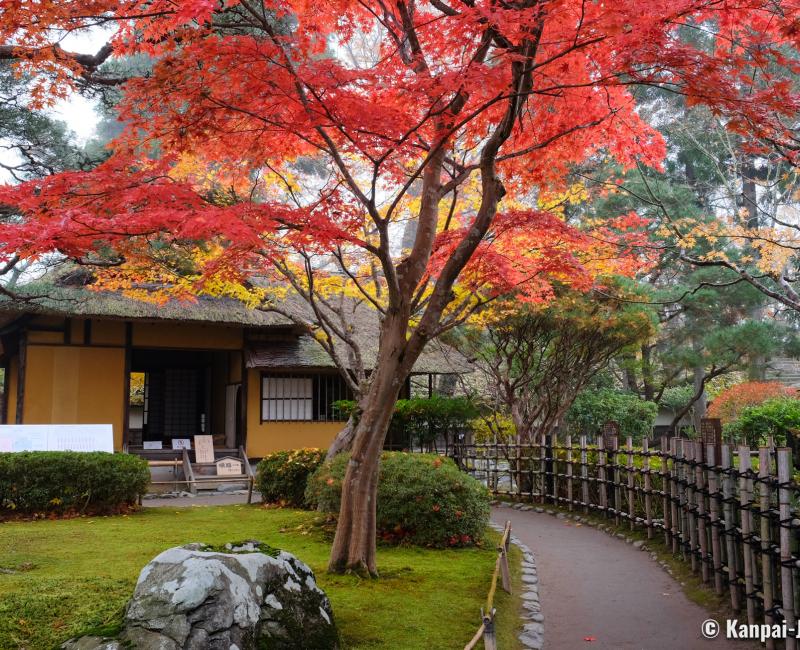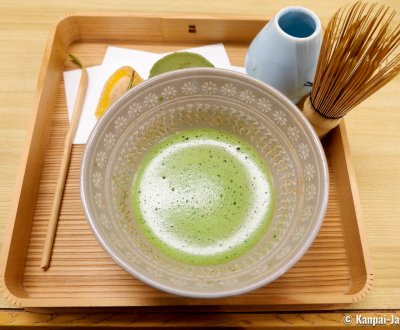Japanese Tea
🍵 The Subtle Flavors of Matcha and Sencha
Japanese tea or nihoncha usually designates a green tea served either brewed, like sencha, or as a powder whisked into water, like matcha, but the green tea range in Japan is larger than that. The drink became popular during the Edo period (1603 – 1868) and is now widely exported in Western countries, especially for its health benefits.
Japanese people prefer green tea for its clear color and refreshing taste that are a better match with umami, the subtle 5th basic taste they particularly enjoy, than black tea or oolong tea which have stronger aromas. In the same way as the Japanese beer 🍺, which is a bottom fermentation pale lager, the Japanese tea (日本茶 nihoncha) is a non-oxidized green tea (緑茶 ryokucha) that one can drink throughout the day, alone or with a meal, warm or cold in summer.
A non-exhaustive list of the most renowned and most popular types of teas in Japan include:
- Matcha powder(抹茶), whisked in hot water to make a creamy foam of a beautiful green, it is the drink served during the traditional tea ceremony;
- Sencha (煎茶), the most common tea in Japan, served brewed;
- Hojicha (ほうじ茶), a roasted green tea, very popular paired with a meal at the restaurant;
- Genmaicha (玄米茶), a green tea flavored with puffed brown rice;
- Gyokuro (玉露), a high quality green tea, from the first spring harvest of tea leaves (first flush);
- Bancha (番茶), on the opposite, is an ordinary green tea, made from the residues of sencha and tencha (tea before grounding into matcha powder) making;
- Mugicha (麦茶), a roasted barley infusion, without caffeine, suitable to children and pregnant women.

Tea is everywhere in Japan:
- In supermarkets, in konbini and in specialized shops;
- In restaurants and Japanese fast-foods, regardless of their price ranges;
- In coffee shops chains like Starbucks or Tully's;
- In independent tea rooms;
- In Buddhist temples and traditional tea houses, especially when they have a garden for a contemplative break;
- At matsuri festivals food stalls; and, lastly,
- In jidohanbaiki drinks vending machines at every street corner.
The choices are almost endless for tourists who would like to drink green tea in Japan: they’ll find it in bulk selling, in bags or sticks or ready to drink in bottles. Ito En is the most widespread industrial green tea brand in the archipelago.

History and geography of tea in Japan
Imported by Buddhist monks returning to the archipelago after studying in China from where the plant originates, tea was supposedly first introduced in Japan as soon as the Nara period (710 - 794) at the imperial court. Then, in the 9th century, the first tea trees of Camellia sinensis, a species with small leaves, were planted in the area around Kyoto, especially in Uji: to this day Uji City is still considered the historical capital of tea in Japan. The development and popularization of tea in Japan is usually marked by 3 dates associated with 3 important personalities:
- In 1191, monk Eisai or Yosai (1141 - 1215), founder of the Zen Rinzai school in Japan, brought back from China tea seeds he planted in the temples’ gardens, and also a new method to pound the leaves into powder, similar to the making of matcha tea. He promoted tea first for its medicinal and naturally stimulating properties, rather than for its taste.
- In the 16th century, tea master Sen no Rikyu (1522 - 1591) established the codes of the tea ceremony (called Chanoyu or Sado) that uses matcha and therefore integrates tea at the center of the traditional Japanese culture. This refined practice was particularly enjoyed by the samurai warrior class during the feudal period.
- In 1738, tea producer Nagatani Soen (1681 – 1778) invented the sencha making process in Ujitawara, a small town of nowadays Kyoto prefecture; from this time on, sencha has become the tea people drink daily in Japan.

Tea fields to visit from Shizuoka to Kyushu
Nowadays, Japan’s great tea producing regions extend on specific areas, mirroring the history of tea, imported from China and traveling through the trading ports in the south of Japan, as well as the environmental conditions necessary to grow tea, such as a soft and rich soil like volcanic ground, with a mild temperate climate, sunny and protected from the wind.
For those who would like to visit a tea plantation, we recommend the following itinerary:
- Start in the south of Tokyo with the cities at the foot of Mount Fuji 🗻 and Shizuoka, the prefecture being the 1rst sencha producer in Japan;
- Then Kyoto and its satellite cities, cradles of tea like Uji, Ujitawara and Wakura that all grow "Ujicha" tea, a local appellation encompassing matcha, sencha and gyokuro;
- Continue to Mie prefecture, the 3rd most important tea producer in Japan (Isecha), specialized in the kabusecha (かぶせ茶), one of the 3 most expensive Japanese green teas; and,
- The small and little known town of Nishio in Nagoya Bay, that actually produces the largest part of matcha powder in the archipelago;
- Continue further on Kyushu Island with Fukuoka, renowned for its gyokuro;
- Ureshino village in Saga prefecture, for its local high-end green tea; and, lastly,
- Kagoshima, the 2nd prefecture regarding green tea production with fields located at the foot of the Sakurajima volcano, especially around the old feudal city of Chiran.
In the fields, guided tours allow to learn more about the harvesting and the making of Japanese green tea, as well as the local specialties. The journey is an occasion to enjoy tea in all forms available, as drinks but also as ingredients used in delicacies like matcha ice creams and matcha pastries, or in green tea soba noodles. At the most traditional places, tea ceremony experiences are often offered in a chashitsu, a tea pavilion.
We recommend May, October and November to visit the tea plantations and discover their surrounding culture, especially local craftsmanship, ceramics and other traditional utensils to prepare and drink tea in Japan.

Dates celebrating Japanese tea
The Japanese Tea Day, called 日本茶の日 Nihoncha no Hi, is celebrated 2 times in October every year:
- October 1rst is the celebration organized by the Ito En brand since the 2000s, in homage to the great tea ceremony performed in 1587 at Kitano Tenmangu shrine, led by Sen no Rikyu himself and in attendance of the then ruler of Japan, Toyotomi Hideyoshi;
- October 31 marks the historical date of monk Eisai’s return from China with tea tree seeds on 1191, October 31rst and the beginning of the drink’s spreading in Japan.
Other days also celebrate specific kinds of teas, such as:
- November 1rst: the genmaicha day(玄米茶の日 Genmaicha no Hi);
- February 6: the matcha day (抹茶の日 Matcha no Hi) since 1992;
- May 2: the green tea day (緑茶の日 Ryokucha no Hi) as a reference to the 1rst spring harvest, that is considered to be the best.

Green tea’s making and benefits
The harvest of leaves is the first step in the tea making process and it is also the farmers’ most intensive work period. Harvests are made several times in the year, each period having an impact on the taste of the tea and its quality. Therefore, the 1rst spring 🌸 harvest (taking place between mid-April and early June depending on the area), is directed to the production of the most high-end teas. Tea leaves are harvested again during summer (depending on the heat), then in autumn 🍁.
In order to prevent photosynthesis and the development of a bitter taste, the tea fields can be placed under a shading to protect them from the sun. The duration of the process varies according to the kind of green tea, and some fields remain uncovered all year long.
The harvested leaves are steamed (the Japanese process to make sencha) then dried and dehydrated. The last steps of the making process leads to the conditioning of the leaves: classical brewing green tea is packaged into rolls, and leaves are ground into powder for matcha. The latter is a long and delicate process, as a too fast grounding speed makes the tea burn and loose all its flavors and medicinal properties.

Ever since its introduction in Japan by Buddhist monks and through the imperial court, matcha powder’s many benefits have been recognized, making it very popular in Japan as well as in Western countries. Beside the prestige of the tea ceremony, and according to the Japanese, matcha is indeed supposedly efficient for:
- Preventing getting a cold in winter as it is rich in vitamins and minerals;
- Helping weight loss thanks to its fat burner action when drunk without additive;
- Preventing cavities and bad breath;
- Preventing food poisoning;
- Helping preserve a beautiful skin;
- Giving energy to stay awake; and,
- Lowering the probability of a cancer.
Green tea indeed contains several natural ingredients that are considered beneficial for health provided not excessively consumed (no more than 5 cups per day), such as:
- Catechin, a flavonoid with anti-inflammatory and anti-oxidant properties;
- Amino acids, such a L-theanine, GABA and sodium glutamate (the flavor enhancer activating umami);
- Tea caffeine (theine);
- Fluorine;
- B and C vitamins;
- Minerals; and,
- Cellulose.
The inexperienced might find the taste of matcha very specific, pungent with a bitterness stronger than those of a brewed tea. It is however easy to drink as a latte, that is to say mixed with (vegetal) milk, that helps soften the bitterness. As a general rule, Japanese green teas have very soft vegetal flavors, with salt and algae aromas, characteristic of the Pacific Coast areas where they are grown.

